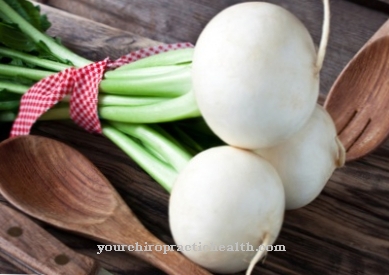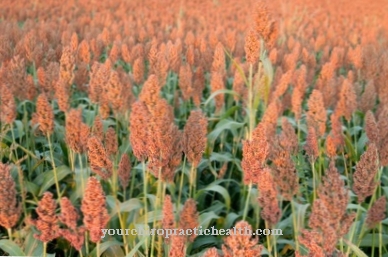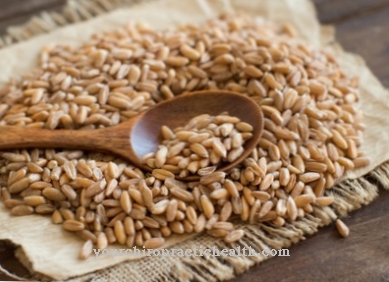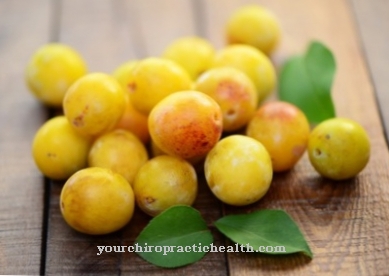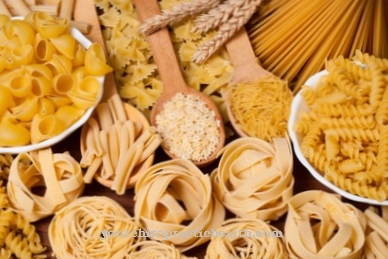The one originally from the region of Central America Musk gourd (or Musk gourd) from the cucurbitaceae family is one of the five leading pumpkin varieties that are grown worldwide. Other types of pumpkin, which are equally appreciated from a culinary point of view, such as nutmeg, butternut and snake pumpkin, also belong to the musk pumpkin variety. The annual plant grows up to 6 meters long and the fruits are reminiscent of the shape and color of watermelons.
What you should know about the musk gourd

The musk gourd (Cucurbita moschata) from the Cucurbitaceae family is one of the top five pumpkin varieties that are grown for commercial purposes in warm countries around the world. Other pumpkin varieties that are valued for human consumption, such as nutmeg, butternut and snake squash, also belong to the musk squash.
The typical harvest time for the musk squash extends from August to October in cultivation regions in the northern hemisphere. At temperatures in the range of 10 to 13 degrees Celsius, musk pumpkins can be kept for months if they are undamaged. However, a cut pumpkin will only keep fresh in the refrigerator for 2 to 3 days. The musk pumpkin is valued for its tasty pulp and for its seeds, which contain a valuable oil. It has its origin in Central America, in a region that stretches from the southern states of the USA via Mexico and Central America to Colombia.
Archaeological finds suggest that pumpkins may have been around since the 10th millennium BC. Were cultivated. Since there is no longer any wild or stem form of the musk pumpkin, an exact localization of its origin is not possible. Like the other cucurbits, the musk gourd is an herbaceous, annual climbing plant that can grow up to 6 meters long. The light to thick hair on the stems and leaves is characteristic of the musk gourd. The fruits, which are called armored berries like the other pumpkin varieties, are dark green, spherical and resemble watermelons in appearance.
However, the flesh differs significantly from that of the watermelon, it is bright yellow to orange in color. The plant is monoecious with separate-sexed flowers (monoecious). The musk gourd prefers a warm to hot, not too dry, climate for its cultivation. In tropical areas, the musk gourd is the most common variety in commercial cultivation.
Importance to health
The health significance of the musk pumpkin, as with the most well-known other pumpkin varieties, lies less in the primary ingredients than in the secondary plant substances.
When it comes to the primary ingredients proteins, fats and carbohydrates, the musk pumpkin has little to offer, so its calorific value is very low at 79 kJ (19 kcal) per 100 grams of pulp. In addition, the indigestible fiber content is also very low. This means that the pumpkin meat is light and easy to digest. Musk pumpkin is therefore also highly recommended for calorie-conscious people. The versatile preparation options and the low calorie content promise culinary enjoyment "without regrets".
The musk pumpkin has more to offer than just a low calorie content. The pumpkin scores points with various phytochemicals. The content of potassium, carotenoids as precursors for vitamin A and some B vitamins such as B1, B2 and B6 are of particular relevance to health. The secondary ingredients have a positive effect on high blood pressure and have a preventive effect against cardiovascular diseases and strokes.
Pumpkin seeds, which contain a valuable oil with polyunsaturated fatty acids, are of particular importance with health relevance. In addition, the silica contained in the pumpkin has a positive effect on the skin, hair and nails. However, the vitamin C content is at the lower end of all pumpkin varieties, so that no significant impact on health is to be expected.
Ingredients & nutritional values
| Nutritional information | Amount per 100 gram |
| Calories 45 | Fat content 0.1 g |
| cholesterol 0 mg | sodium 4 mg |
| potassium 352 mg | carbohydrates 12 g |
| Fiber 2 g | protein 1 g |
The relatively low nutritional value of the musk pumpkin is compatible with the low content of primary ingredients. Fats are only contained in the valuable oil of the kernels (pumpkin seed oil). The protein content averages 0.2 g per 100 g of fruit pulp, and the carbohydrates that can be used by the body's metabolism are only weakly represented at a concentration of around 4.1 g per 100 g.
The value of the pumpkin lies in its content of secondary ingredients. Particularly noteworthy is the high content of potassium (0.49 mg), beta-carotene (3.1 mg) and vitamins B1 (34 µg), B2 (55 µg) and B6 (110 µg). At a few milligrams, the vitamin C content is well below other types of pumpkin such as “Red Hokkaido”.
Intolerances & allergies
Food intolerances or allergies in connection with the consumption of musk pumpkin occur only rarely and are hardly documented. However, it is to be expected that intolerance or allergies that have arisen from eating any vegetable from the pumpkin family - including cucumbers, for example - will with a certain probability also develop with this type of pumpkin.
As a rule, symptoms tend to be mild if there are intolerances. In rare cases facial redness, facial swelling or similar symptoms may occur, and in extremely rare cases anaphylactic shock may occur after eating the pulp, which requires emergency medical attention.
Shopping & kitchen tips
The chance to find the freshest musk pumpkin possible in stores or on weekly markets is given during the main harvest season from mid-August to the end of October. If the pumpkin is to be stored for a longer period of time before processing, it is advisable to make sure that the skin is intact, has no dents and that there is at least 2 to 3 centimeters of the stem on the pumpkin.
If the stem is no longer there, there is a risk that putrefactive bacteria will enter the pumpkin or have already entered and reduce the shelf life. In principle, musk pumpkins can be kept fresh for months in a cool cellar if they were not fully ripe when you bought them, which can be recognized by the color of the skin. The fruits are fully ripe when the skin turns a golden yellow color and when a hollow tone appears when you tap the pumpkin. The pumpkin meat is also ideal for freezing raw or cooked.
Pickled pumpkin, e.g. B. in a sweet and sour marinade is ideal for storage in tightly screwed glasses at cellar temperature. To prepare the pumpkins you need a larger, sturdy knife for peeling and dicing the pulp. The seeds can be removed with a spoon along with the soft fibrous flesh in the center of the pumpkin and cooked separately.
Preparation tips
The easiest way to prepare the pumpkin is to dice the pumpkin flesh and boil or stew it to use it as a vegetable accompaniment to many dishes. Alternatively, the pulp can be pureed and made into soups.
In many cases, the pulp and seeds are also used to prepare desserts or the roasted seeds are used for snacks. Alternatively, the cooked pumpkin meat cubes can be placed in a sweet and sour marinade and give almost all salads an exotic and extremely tasty note.

